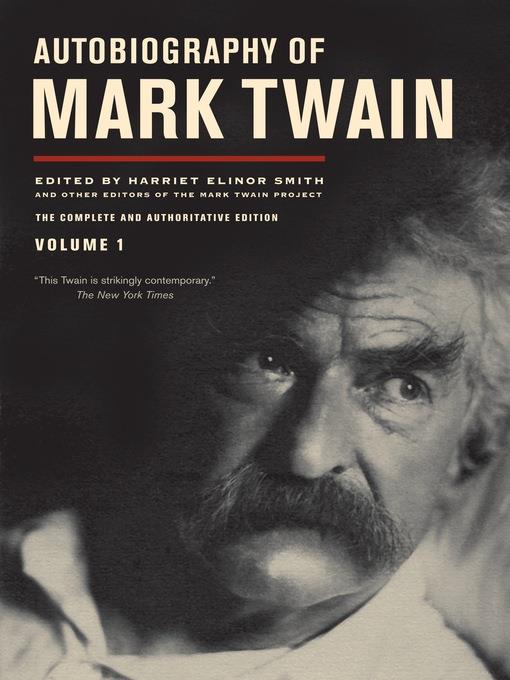
Autobiography of Mark Twain
The Complete and Authoritative Edition, Volume 1
کتاب های مرتبط
- اطلاعات
- نقد و بررسی
- دیدگاه کاربران
نقد و بررسی

September 30, 2013
Several chapters into this sprawling volume, Mark Twain (“Sam,” to his friends) professes: “I can say now what I could not say while alive—things which it would shock people to hear.” Though not quite shocking, these rambling reminiscences (spanning 1860 to 1906, when Twain began dictating them) offer tart appraisals of matters personal (“In the early days I liked Bret Harte . . . but by and by I got over it”), political (“ represents what the American gentleman ought not to be, and does it as clearly, intelligibly, and exhaustively as he represents what the American gentleman is”), and universal (“The political and commercial morals of the United States of America are not merely food for laughter, they are an entire banquet”). The detailed and digressive narrative ping-pongs back and forth between the past and present, covering incidents including: Twain negotiating the publication of Ulysses S. Grant’s memoirs; his youthful interest in mesmerism; the San Francisco earthquake of 1906; and swindles he endured from publishers. Twain traveled extensively and befriended many luminaries, and his colorful experiences give the book the same Dickensian scope as the first volume, and presents a vivid picture of America in the 19th century and Twain’s indelible mark on it. 50 b&w photos.

September 7, 2015
This third and final volume of Twain's half-million-word autobiography begins with an amusing reminiscence about a rascally jewelry salesman, dictated in 1907, and ends with a wail of anguish over the tragic death of his daughter, Jean, in 1909. In between, there occur all manner of engrossing events and experiences, including Twain's receipt of an honorary degree from Oxford University, employment of a man masquerading as a housemaid, luncheon with George Bernard Shaw, travels abroad to England and Bermuda, and audiences with Andrew Carnegie and other famous personalities of the day. Twain recalls his twilight years' main events in roughly chronological order, but each serves as a touchstone for digressions and reveries on experiences described in his autobiography's two earlier volumes. Twain's expansiveness occasionally deflates into numbing levels of detail, but he is usually as sharp and witty here as he in his fiction, particularly when gleefully goring his favorite bête noir, President Theodore Roosevelt. Life, in Twain's opinion, is a "procession of episodes and experiences which seem large when they happen, but which diminish to trivialities as soon as we get perspective upon them." This fascinating volume gives lie to that assertion, and closes the book on the remarkable life of one of America's most outstanding literary talents. With extensive scholarly annotations. B+w photos.

Starred review from September 15, 2010
Before his death in 1910, Mark Twain left instructions that his autobiography, on which he'd been working by fits and starts, be left unpublished for 100 years. Now, at the century mark, from the army of Twain scholars at the University of California's Mark Twain Project, comes the dazzling first volume of the ultimate, authoritative three-volume Autobiography of Mark Twain. With no fear of reprisals, always in the center of mid-19th-century America's political, social, and cultural life, and acquainted with everyone of note, Twain wrote briskly and both favorably and fiercely on how he felt about people and events. Twain's writing here is electric, alternately moving and hilarious. He couldn't write a ho-hum sentence. Disappointed with other systems of organization, Twain settled on writing on a topic that interested him before switching to another when it so moved him. To read this volume is to be introduced to Twain as if, thrillingly, for the first time. A 58-page introduction, 138 pages of "Preliminary Manuscripts and Dictations," 176 pages of "Explanatory Notes," and a section of "Family Biographies" (all freshly fascinating) round out the volume. VERDICT Enthusiastically recommended. This may overwhelm Twain newcomers, but it is essential for specialists.--Charles C. Nash, formerly with Cottey Coll., Nevada, MO
Copyright 2010 Library Journal, LLC Used with permission.

Starred review from September 15, 2010
In explaining his dissatisfaction with his early attempts to write his life story, Mark Twain blamed the narrowness of the conventional cradle-to-grave format: The side-excursions are the life of our life-voyage, and should be, also, of its history. This volumethe first of threemakes public autobiographical dictations in which Twain unpredictably pursues the many side-excursions of his remarkably creative life. Embedded in a substantial editorial apparatus, these free-spirited forays expose private aspects of character that the author did not want in print until he had been dead at least a century. Readers see, for instance, a misanthropic Twain consigning man to a status below that of the grubs and worms, as well as a tenderhearted Twain still grieving a year after his wifes death. But on some side-excursions, Twain flashes the irreverent wit that made him famous: Who will not delight in Twains account of how, as a boy, he gleefully dons the bright parade banner of the local Temperance Lodge, only to shuck his banner upon finding a cigar stub he can light up? But perhaps the most important side-excursions are those retracing the imaginative prospecting of a miner for literary gold, efforts that resulted in such works as Roughing It and Innocents Abroad. A treasure trove for serious Twain readers.(Reprinted with permission of Booklist, copyright 2010, American Library Association.)

























دیدگاه کاربران